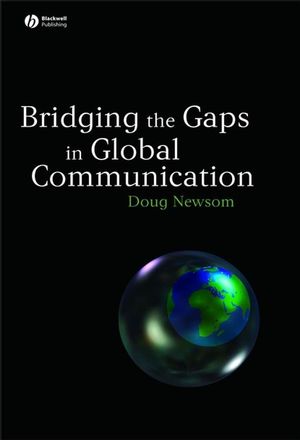Bridging the Gaps in Global CommunicationISBN: 978-1-4051-4411-7
Hardcover
168 pages
October 2006, Wiley-Blackwell
 This is a Print-on-Demand title. It will be printed specifically to fill your order. Please allow an additional 10-15 days delivery time. The book is not returnable.
Other Available Formats: Paperback
|
||||||
List of Figures.
Part I: Global Sources and Systems of Communication: Concepts, Economics, and Politics.
1. Organization of Information .
1.1. Sources of Information.
1.1.1. Interpersonal channels.
1.1.2. Extrapersonal relationships, usually public ones.
1.2. Systems of Communication.
1.2.1. Mass communication.
1.2.2. Organizational: profit and nonprofit.
1.3. Summary.
2. Concepts.
2.1. Information for Individual Decision Making.
2.2. Information for Communal Decision Making.
2.3. Thinking Differently and Avoiding Assumptions.
2.4. Summary.
3. Politics.
3.1. Government Structure.
3.2. Institutional Freedoms.
3.3. Individual Freedoms.
3.4. Summary.
4. Economics .
4.1. Commercially Based Economies (Competitive).
4.2. Government-based Economies (Supportive).
4.3. Summary.
Recap for Part I, Global Sources and Systems of Communication: Concepts, Economics, and Politics.
Part II: The Cultural Context in which Information Is Received, Interpreted, and Understood.
5. Nonverbal Interaction: Action, Sound, and Silence.
5.1. Music.
5.2. Dress.
5.3. Food.
5.4. Expressions.
5.5. Summary.
6. Theories of Signs and Language.
6.1. Signs.
6.1.1. Gestures.
6.1.2. Public information signs.
6.1.3. Symbols.
6.1.4. Logos.
6.1.5. Advertising.
6.2. Signs as Persuasive Images.
6.3. Language.
6.3.1. Semantics.
6.3.2. Syntactics.
6.3.3. Pragramatics.
6.4. Summary.
7. Theories of Symbolic Interaction, Structuration, and Convergence.
7.1. Application.
7.2. Limitation.
7.3. Summary.
8. Theories of Discourse.
8.1. Agenda Setting on a Global Level.
8.2. Speech-act Theory.
8.3. Summary.
9. Frames of Reference.
9.1. Attachment of Meanings.
9.2. Experiences.
9.3. Living in Two (or More) Cultures.
9.4. Summary.
10. Ethical Issues.
10.1. Sensitivities.
10.2. Interpretations.
10.3. Summary.
11. Legal Issues.
11.1. Government.
11.2. Religion.
11.3. Summary.
12. The Roles of Advertising and Public Relations .
12.1. Advertising.
12.1.1. Illustrations.
12.1.2. Product information.
12.2. Public Relations.
12.2.1. Policies.
12.2.2. Practices.
12.3. Summary.
13. Miscommunication and Consequences.
13.1. Mass Communication/Editorial Content.
13.2. Commercial/Promotional Content.
13.3. Summary.
14. Developing a Worldview.
14.1. Personally.
14.2. Professionally.
14.3. Summary



